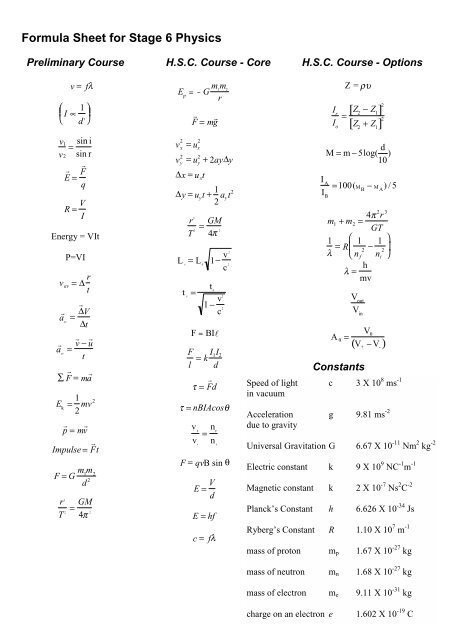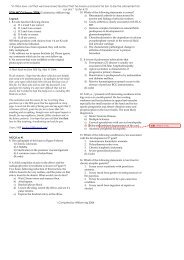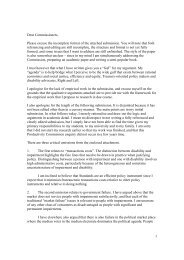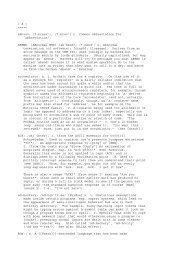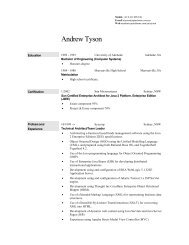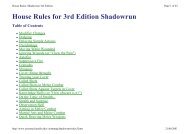Formula Sheet for Stage 6 Physics
Formula Sheet for Stage 6 Physics
Formula Sheet for Stage 6 Physics
- No tags were found...
Create successful ePaper yourself
Turn your PDF publications into a flip-book with our unique Google optimized e-Paper software.
<strong>Formula</strong> <strong>Sheet</strong> <strong>for</strong> <strong>Stage</strong> 6 <strong>Physics</strong>Preliminary Course⎛ ⎜⎝v = fλI ∝ 1 2d⎞⎟⎠v 1v = sin i2 sin rrE =rFqR = V IEnergy = VItP=VIH.S.C. Course - CoreE p= - G m 1m 2rv x 2 = u x2rF = mgrv y2= u y2+ 2ay∆y∆x = u x t∆y = u y t + 1 2 a yt 2r 3T 2= GM4π 2L v= L 01− v 2c 2H.S.C. Course - OptionsI rZ=ρυ[ ] 2[ ] 2= Z − Z 2 1I o Z 2+ Z 1dM = m − 5log( )10I AI B=100(M B− M A)/5m 1 + m 2 = 4π 2 r 3GT1λ = R ⎛ 12n − 1 ⎞⎜2 ⎟⎝ f n i ⎠λ = h mvv av =∆ r tra av=r∆ V∆trr v − ura av=tr∑ F = marE k= 1 2 mv 2rp = mvrImpulse = F rtF = G m 1 m 2d 2r 3T 2= GM4π 2t v=Flt 01 − v2c 2F = BIl= k I 1I 2dτ = rF dτ = nBIAcosθv pv s= n pn sF = qvB sin θE = V dE = hfc = fλA 0 =V outV inConstantsV 0( )V + −V -Speed of light c 3 X 10 8 ms -1in vacuumAcceleration g 9.81 ms -2due to gravityUniversal Gravitation G 6.67 X 10 -11 Nm 2 kg -2Electric constant k 9 X 10 9 NC -1 m -1Magnetic constant k 2 X 10 -7 Ns 2 C -2Planck’s Constant h 6.626 X 10 -34 JsRyberg’s Constant R 1.10 X 10 7 m -1mass of proton m p 1.67 X 10 -27 kgmass of neutron m n 1.68 X 10 -27 kgmass of electron m e 9.11 X 10 -31 kgcharge on an electron e1.602 X 10 -19 C
How to Use the <strong>Formula</strong>s <strong>for</strong> <strong>Stage</strong> 6 <strong>Physics</strong>Preliminary Course<strong>Formula</strong> Name Comments Typical Problem Typical Answerv = fλWave v= velocity (m/s)Calculate the wavelengthv 3Equation f = frequency (hz)of a water wave travellingv = f λ ∴λ= = = 0. 5mf 68.2.1 λ = wavelength (m)at 3 m/s whose frequency⎛ ⎜⎝I ∝ 1 2d2⎞⎟⎠v 1 sin i= ( =1nsin rv2)Intensity Law8.2.3Snell’s Law8.2.4rr FElectric FieldE =q8.3.2R = V IEnergy = VItP=VIOhm’s Law8.3.2ElectricalEnergy8.3.4ElectricalPower8.3.4I = intensity (no units)d = distance (m)v 1 = speed in first mediumv 2 = speed in second mediumsin i = angle in first mediumsin r = angle in second medium• Angles are alwaysmeasured to the normalE = Electric field (N/C, V/m)F = Force (N)q = charge (C)R = resistance (Ω)V = voltage (V)I = current (A)Energy (J)V = voltage (V)I = current (A)T = time (s)P = power (W)V = voltage (V)I = current (A)is 6 Hz.A globe is viewed from 2metres at a certainbrightness. How brightdoes it appear 6 metresaway?A light ray travelling at 3X 10 8 m/s in air enters apool of water at 45° to thenormal. If it slows downto 2.4 X 10 8 m/s, what isits angle in the water?What is the <strong>for</strong>ce exertedon a 2 X 10 -6 C chargemoving in an electric fieldof size 5 X 10 3 V/m?What is the currentthrough a 6Ω resistorwhen a voltage of 18 V isapplied across it?How much energy isdelivered to an electrickettle if a current of 2A isused <strong>for</strong> 3 minutesplugged into the mains(240V)?What current is requiredby a 2400W electric heaterplugged into the mains(240V)?⎛ 1 ⎞⎜1I ∝ ⎟∴d→ 3d,→⎜2⎟2⎝ d ⎠dbright.v = ∴sinrsin r=v1 sin i v2sin2v1i19thus it appears 9 times less8 o2.4 × 10 sin 45 o== 3883×10rr F−63E = ∴F= qE = 2 × 10 X 5 × 10 = 0. 01NqV V 18R = ∴ I = = = 3AI R 6Energy = VIt = 240 X 2 X 3 X 60 (sec)= 86400 = 86.4 kJP 2400P = VI ∴ I = = = 10AV 240
<strong>Formula</strong> Name Comments Typical Problem Typical Answerv av=∆ r Average v av = average velocity (m/s) How much distance isrtVelocity r = distance covered (m) covered by a car travellingvav = ∆ ∴r= vav× ∆t= 16 × 4 × 60 = 384mt8.4.1 t = time (s)<strong>for</strong> 4 mins at an averagera avr∆V=∆tAverageAcceleration8.4.2r r∑ F = ma Newton’sSecond Law8.4.2E k= 1 2 mv 2rp = mvrImpulse = rF tF = G m 1m 2d 2r 3T 2= GM4π 2KineticEnergy8.4.3Momentum8.4.4Impulse8.4.4UniversalGravitation8.5.4Kepler’s ThirdLaw8.5.4a r av= average acceleration (ms -2 )δv = change in velocity (m/s)δt = change in time (s)∑ F r = sum of all <strong>for</strong>ces (N)m = mass (kg)a r = acceleration (ms -2 )E k = kinetic energy (J)m= mass (kg)v = speed (m/s)P = momentum (Ns, kgm/s)m = mass (kg)v = velocity (m/s)Impulse = change in momentum(Ns, kgm/s)F = <strong>for</strong>ce (N)G = universal gravitationconstant (6.67 X 10 -11 Nm 2 kg -2 )m 1 = mass of body 1 (kg)m 2 = mass of body 2 (kg)d = separation between the twobodies (m)r = radius of motion (m)T = period of motion (s)G = universal gravitationconstant (6.67 X 10 -11 Nm 2 kg -2 )M = mass of system (kg)speed of 16 m/s?A train accelerates from12 m/s to 18 m/s in 12 s.What is the value of thisacceleration?A ball possesses 10 J ofenergy. What is its mass ifit is moving at 2 m/s?What is the momentum of1400 kg car moving at 6m/s?A ball of mass 0.5 kgtravelling at 3 m/s hitswall and bounces back atthe same speed. If it is incontact with the wall <strong>for</strong>0.1 s, what is the <strong>for</strong>ceexerted by the wall?What is the gravitational<strong>for</strong>ce between the Earth(m=6X10 24 kg) and 2 kgball given that the radiusof the Earth is 5.8X10 6 mWhat is the period of a10 12 kg comet that orbits at5 X 10 8 m?ra avr∆V18 −12−= = = 0.5ms∆t121 2E2 × 10E = mv ∴m=22v 2r rp = mv = 1400 × 6 = 8400kgms2kk= =22−15kgImpulse = pf− pi= m( vf− vi) = 0.5(2 − ( −2))r Impulse 2Impulse = Ft ∴ F = = = 20Nt 0.1−1124m1m26.67×10 X 2X6X10F = G == 19. 6N26 2d (5.8×10 m)rTGM∴T=24π24πrGM4π6.67X10X 5X10332= =2−118X1012= 17203s
How to Use the <strong>Formula</strong>s <strong>for</strong> <strong>Stage</strong> 6 <strong>Physics</strong>HSC Course (Core)<strong>Formula</strong> Name Comments Typical Problem Typical AnswerE p= - G m 1m 2 Gravitationalm m2r Potential= − GrEnergy9.2.1rF = mgrv x 2 = u x2v 2 y = u 2 y + 2ay∆y∆x = u x t∆y = u y t + 1 2 a yt 2r 3T 2= GM4π 2L v= L 01− v 2t v=t 01 − v2c 2c 2GravitationalForce9.2.1Newtons’ Lawsof Motion9.2.2Kepler’s thirdlaw9.2.2RelativisticLengthContraction9.2.4Relativistic timedilation9.2.4E p = Potential energyG = universal gravitation constant(6.67 X 10 -11 Nm 2 kg -2 )m 1 = mass of body 1 (kg)m 2 = mass of body 2 (kg)r = separation between the twobodies from infinity to r (m)F = <strong>for</strong>ce (N)M = mass (kg)g = gravitational constant at thesurface of the Earth 9.81 ms -2u x = initial speed in x direction (m/s)v x = final speed in x direction (m/s)u y = initial speed in y direction (m/s)v y = final speed in y direction (m/s)a = constant acceleration (ms -2 )δx, δy = change in displacement (m)t = time (s)r = radius of motion (m)T = period of motion (s)G = universal gravitation constant(6.67 X 10 -11 Nm 2 kg -2 )M = mass of system (kg)L v = apparent length (m)L o = “rest” length (m)v = relative velocity (m/s)c = speed of light (3 X 10 8 m/s)t v = apparent time (s)t o = “rest” time (s)v = relative velocity (m/s)c = speed of light (3 X 10 8 m/s)What is thegravitational potentialenergy between two100 kg massesthrough a distance of2000 m?What is the weight ofa 100 kg person?What is the maximumheight of a projectilelaunched at 45° to thehorizontal at 50 m/s?What is the period ofa 10 12 kg comet thatorbits at 5 X 10 8 m?What is the apparentlength of a spaceshipof rest length 150mtravelling at 0.9c?How much slowerdoes an astronauttravelling at 0.9cappear to an observer“at rest”−1116.67X10X100X100−12E p== 3.3X10J2000rF = mgr = 100 X 9.81 = 98. 1NLet up be positive.At max. height, v y =0, thus2 2 2 o0 = u + 2ay∆y= u sin 45 − 2X9. 81y∆yv2u sin 45∴ y =2X9.81rTg50=X sin19.6452 o 2 2 oGM∴T=24π24πrGM4π=6.67X10X 5X10332= =2−112L v(0.9c)= L01−= 150 1−2cc2t2v=tv1−c1(0.9c)1−2c0v= == =22210.1965.4m8X1012= 17203s2.29 times slower
<strong>Formula</strong> Name Comments Typical Problem Typical AnswerF = BIlMagnetic <strong>for</strong>ceon a currentcarryingwire oflength l in amagnetic field9.3.1F = <strong>for</strong>ce (N)B= Magnetic Field (T)I = current (A)l = length (m)Calculate the <strong>for</strong>ce on2m of wire carrying acurrent of 4A in amagnetic field of0.1T.F = BIl= 0.1X 4X2 = 0. 8NFl= k I 1I 2dτ = rF dForce per unitlength9.3.1torque9.3.1τ = nBIAcosθ torque on a coilimmersed in amagnetic field9.3.1vpvs= n pnsTrans<strong>for</strong>merequation9.3.4F = <strong>for</strong>ce (N)l = length (m) per unitI 1 , I 2 = two currentsparallel=repulsive,antiparallel=attractived = separation of the two currents(m)k=magnetic constant (2 X 10 -7 NC -1 m -1 )τ =torque (Nm)F =<strong>for</strong>ce (N)d=distance (m)τ =torque (Nm)n =number of turns of coilB=magnetic field (T)I = current (A)A = area of coil immersed inmagnetic field (m 2 )cos Θ=angle between the coil andthe magnetic fieldV p = primary voltage (V)V s = secondary voltage (V)N p = number of turns in the primarycoilN s = number of turns in thesecondary coilWhat is the <strong>for</strong>ce perunit length on twowires, both carrying10A, separated by adistance of 3m?What is the torque ona nut when a 0.6 mspanner has a <strong>for</strong>ce of80 N applied on it?What is the torque ona 0.20 m 2 coil of 200turns immersed in amagnetic field of 0.2T carrying a currentof 3 A?A trans<strong>for</strong>mer isrequired to step downmains voltage (240V)to 12 V. If theprimary coil has 960turns, how many turnsare required in thesecondary coil?FlI I= kd= 2X1010X10X = 6.67X1031 2−7−6τ = F rd = 80 X 0.6 = 48Nmτ = nBIAcosθ= 200 X 0.2X3X0.20 = 24Nmvvpsn=nps∴nssnpv=vps960X12= = 48 turns.240N / m
<strong>Formula</strong> Name Comments Typical Problem Typical AnswerF = qvB sin θ Magnetic <strong>for</strong>ceF = qvB sinθ= 1.6X10on a charge in amagnetic field9.4.1E = V dElectric Field9.4.1E = hfEnergy of aPhoton9.4.2c = fλWave Equation9.4.2F = <strong>for</strong>ce (N)q = charge (C)v = velocity (m/s)B = magnetic field (T)Sin Θ = angle between the velocityand the magnetic fieldE = Electric Field (N/C, V/m)V = Voltage (V)d = distance (m)E = Energy (J)h = Planck’s constant 6.626 X 10 -34Jsf = frequency (Hz)c = speed of light 3 X 10 8 m/sf = frequency (Hz)λ = wavelength (m)What is the <strong>for</strong>ce onan electron travellingat 10 5 m/s in amagnetic field of 3 Tat an angle of 30° tothe field?What is the electricfield between theprongs of a mainsoutlet (240V) if itsseparation is 18 mm?What is the energy ofa photon of yellowlight (f=5.1X10 15 Hz)?What is the frequencyof yellow light giventhat its wavelength is590 nm?−19X10VE = 1.33X10V / md= 240 5318X10= −E = hf = 6.67X10c−34X 5.1X108v 3X10fλ∴ f = =λ 590X10=−9515X 3Xsin 30= 3.2X10= 5.1X1015Hzo−18= 2.4X10J−14N
HSC Course (Options)<strong>Formula</strong> Name Comments Typical Problem Typical AnswerZ = ρυAcoustic2Z = ρυ = 0.003X650 = 1.95kgmsImpedance9.6.1IIro=[ Z2− Z1][ Z + Z ]2dM = m − 5log( )10122( = R)I AI B=100(M B − M A )/5m 1+ m 2= 4π 2 r 3GT1λ = R ⎛ 12 − 1 ⎞⎜2 ⎟⎝ n f n i ⎠ReflectionIntensity9.6.1AstronomicalDistance9.7.4Ratio of intensity9.7.4Kepler’s ThirdLaw9.7.5Ryberg’sequation9.8.1Z = Acoustic impedance (kgm 2 s -1=Rayls)ρ = acoustic density (kgm)υ = speed of sound in medium(m/s)I i =initial intensityI o = output intensityZ 2 = acoustic impedance(medium 1)Z 1 = acoustic impedance(medium 2)M = absolute magnitudem = relative magnituded = distance in parsecs55 = 100 = 5.02I A,B = intensity of objects A and BM A,B = absolute magnitude of A& B55 = 100 = 5.02r = radius of motion (m)T = period of motion (s)G = universal gravitation constant(6.67 X 10 -11 Nm 2 kg -2 )M 1 +M 2 = total mass of system(kg)λ = wavelength (m)n i,f = quantum states (shells)R = Ryberg’s constant 1.10 X 10 7m -1What is the acousticimpedance of vaseline giventhat its acoustic density is0.003 kgm and the speed ofsound in vaseline is 650 m/s?What is the reflection intensityat the interface of air (acousticimpedance = 0.5 kgm 2 s -1 ) andvaseline (Z=1.95 kgm 2 s -1 )?How far away is a star thatappears m=4.5 on Earth whileits absolute magnitude is –3.4?How much dimmer is Sirius A(M=-4.3) compared to Echelon(M=-2.1)?Sirius A and B orbit each otherevery 61 years. What is theradius of this orbit if Sirius Ahas a mass of 10 27 kg andSirius B is 10 29 kg?What wavelength of light isproduced in hydrogen by atransition between the first andfourth orbitals (shells)?IIro=[ Z2− Z1][ Z + Z ]M = m − 5 log(214.5−(−3.4)1+5. 021022d10d =I A=100(M B − M A )/5I B(1.95 − 0.5)=(1.95 + 0.5)) ∴d= 1022m−M1+5.02= 143parsec s−1= 0.35T = 61 X 365.25 X 24 X 60 X 60= 1925013600 s2 34πr GT(m31+ m2m1+ m2= ∴r=2GT4π−11276.67X10X1925013600(10+ 10r = 324πr = 6.9 X 10 9 m1 ⎛ 1 1 ⎞7 1 1= R⎜− ⎟ = 1.1X10X ( − )⎜2 2⎟2 2λ⎝ n n ⎠4 1f i∴λ =1.1X1071 −81(24= 9.7X101− )21m29)
<strong>Formula</strong> Name Comments Typical Problem Typical Answerλ = h Wavelength of a λ = wavelength (m)What is the wavelengthmvparticle h = Planck’s constant 6.626 X 10 - associated with an elephantX −34h 6.626 10−λ = == 1.2X1037 m9.8.234 mv 1400X4Js(m=1400 kg) moving at 4 m/s?m = mass of particle (kg)v = speed of particle (m/s)VAmplifier Gain Voutout = output voltage (V) A BC547 transistor has a gain VoV9.9.6V in = input voltage (V)of 120. What is the output h = ∴Vo= VihFE= 120X60X10inVivoltage if the input voltage is60 mV?VA 0= 0Open Gain Loop A o = Amplifier gainA 741 op-amp has an outputV012( V +−V - ) 9.9.6V o = output voltage (V)voltage of 12 V when its V + is A0= = = 10.9( V+− V-) (2.3 −1.2)V + = positive input voltage (V) 2.3 V and its V - is 1.2 V.V - = negative input voltage (V) What is its gain in thisconfiguration?− 3FE= 0. 72V


